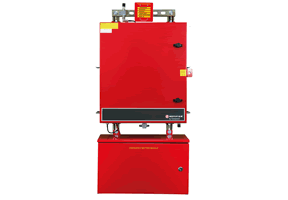
Remote satellite antennas have suggested coverages similar to a fire alarm system and requirements for coverages of smoke detectors. This means numerous antennas may be required on several floors and throughout the building. All of these remote antennas are then interconnected through the use of a coax cable, thereby putting into play proper life safety cable methods and survivability requirements.
This Amplifying Antenna equipment needs to be installed in a manner that assures optimal performance under the worst possible emergency conditions. When installing these systems, one must consider both the vertical (riser) runs and horizontal circuits. When a coax circuit must serve multiple floors, the traveling wire must be 1-hour protected up to the targeted destination similar to a fire alarm riser circuit serving multiple fire zones.
An Amplifying Antenna System, also referenced as a Bi-Directional Antenna System, in the true sense is an Emergency Communication System and must follow the requirements outlined in NFPA 72 under chapter “24.5.2 Two Way Radio Communication Enhancement Systems”. This requires Municipality approval and then code review, thereby requiring plans and submittals. And as we know, with this submittal, review fees and permit costs will be assessed to the job as common in all life safety review processes.
Components of a Bi-Directional Antenna System
There are 4 main components in assembling a Bi-Directional Antenna system:
- A Radio Frequency (RF) Amplifier Control Cabinet with battery backup, with a specific frequency to match the Municipality frequency requiring FCC approval.
- Satellite Remote Antennas on the floors
- Vertical and Horizontal wiring, with Coax Cable, Barrel type Connectors and Splitters
- And 1 Exterior Building Antenna to reach a stationed fire truck or fire station
NFPA 72
In reviewing the NFPA 72 standard, there are specific critical areas of the building that are called out in NFPA 72 that require 99% RF signal strength. These areas are specifically mentioned and should not be ignored:
- The Emergency Command Center
- Fire Pump Room
- Exit Stairs
- Exit Passages
- Elevator Lobbies
- Standpipe Cabinet Locations
- Sprinkler Valve Locations
- and any other areas deemed critical by the AHJ
Other general areas of the building should also be covered with a 90% signal strength allowance.
Though a Bi-Directional Antenna system is a standalone system operating without the need or shared functions of other systems, the code does require the supervision of the BDA system via the base building fire alarm system. All available trouble contacts made available by the Antenna System Manufacture must be monitored. Troubles signals such as, Signal Booster Strength, Both Primary and Secondary Power Supplies, Antenna malfunctions, and other offered control panel malfunctions. These trouble signals should be individually annunciated in the building command center fire panel and then sent to the outside UL listed monitoring company.
IFC CODE 510
There is another document to be aware of when considering presenting a Bi-Directional Antenna system to a prospective buyer. The requirement to install this BDA system is still subject to some leniency by the AHJ.
According to the IFC, International Fire Code, Section 510, If agreed by the Building Official and the Fire Code Official, a listed wired 2-way communication system may comply with the intent of providing Emergency Responder Radio Coverage in lieu of the installation of a BDA system. For example, a listed 2-way fireman telephone system would comply and satisfy chapters in IFC 510 and NFPA 72.
Ultimately per IFC 510.1.2., the fire code official may deem it unnecessary to install a BDA system.
HRSS/SMG Offers BDA Systems and Life Safety System Design
As you can see, these many parts do add up and require a lot of initial coordination with both building and fire officials. This is a must in determining the installation of a BDA system. If the decision has been made to comply, then comes the design requirements, the submittals, installation of protected circuits, assurance of strong RF signals, interfacing with the life safety system and then testing with the AHJ.
High Rise Security Systems with SMG Security Holdings offers Bidirectional Antenna Systems and assistance with all life safety system design. We provide code compliant fire alarm and life safety systems to meet AHJ approval. Contact us to learn more about your emergency communication requirements including the need for a Bi-Directional Antenna (BDA).


